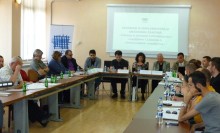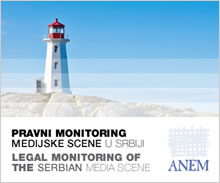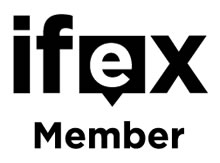29. 05. 2015
REPORT FROM NOVI PAZAR ON ANEM SEMINAR ON THE IMPLEMENTATION OF NEW MEDIA LAWS

After the introductory address by the ANEM president, Milorad Tadic, and the Head of the Media Department of the OSCE Mission to Serbia, Gordana Jankovic, the following representatives of responsible institutions, as well as media and legal experts, presented the key solutions of the new laws and the results of their implementation so far: Slobodan Kremenjak, attorney at law and media law expert, Saša Mirković, state secretary at the Ministry of Culture and Information, Miloš Stojković, attorney at law and member of the ANEM legal team, Rajka Galin Ćertić, assistant director for legal issues, the Regulatory Authority of Electronic Media, and Rade Veljanovski, media expert and professor at the Faculty of Political Sciences, Belgrade.
Slobodan Kremenjak presented key solutions of the Law on Public Information and Media. He said that freedom of expression, as an aspect of media in closest relation to human rights, is already well regulated by the Constitution and ratified international treaties. Media laws should be interpreted and implemented in the same way that the European Court of Human rights does so. In the area of human rights, the new laws are aimed at improving the existing system without compromising the existing good solutions.
The important novelty in the Law is defining media as means of conveying editorially shaped information. This is the first time that the law goes beyond defining media merely as means of conveying information. This is important for distinguishing between what is and what is not a media (e.g. social networks, internet forums etc). Second novelty leads to a clear difference between who may and who may not be media publisher. In relation to this, the Law sets a clear deadline and rules for media privatization. "Publisher" is a new term and it replaced the former term "founder". Third, this law resolved the dilemma whether media may be subject to legal transaction by prescribing that publishing rights over media may be transferred. Fourth, this law brings new rules regarding the control of state aid. By signing the Stabilization and Association Agreement, Serbia took upon itself the obligation to harmonize all of its laws with the EU legislation. An important part of this is the implementation of rules on competition and state aid. While Serbia used to have non-transparent media financing, the Law now attempts to regulate this issue by prescribing that the state aid is possible only if it serves the fulfillment of public interest in the public information sector. The state should ensure conditions for the functioning of media at all its levels, but it should do so in a transparent way and under clear conditions and criteria in order for the aid to lead to the fulfillment of public interest and not particular interest of those in power. Project-based co-financing is at its inception, and is yet to lead to desired results. The conclusion is that there is no alternative solution that could adequately solve this issue and that project-based co-financing is at the time being the best way for the fulfillment of public interest. Yet another novelty is different rules on the Media Register. First, it is prescribed that the Register should contain more information to enable a critical view on the content that media present to the citizens. Additionally, the Register should offer information on the amount of state aid allocated to individual media. The Register is also important for the issue of media concentration. The new Law resolves some issues stemming from the practice, such as impunity for journalists who carry information from documents of responsible state authorities; the rules on reporting on court proceedings were made clearer; the rules on the amount of compensatory damages were made more precise (the rule was established that a person who immediately files a lawsuit, without requesting his/her answer to be published first, will be sanctioned by a lower amount of compensatory damages).
Saša Mirković presented the latest activities of the Ministry of Culture and Information on the implementation of media laws. The Ministry completed the work on the competitions implemented according to the new rules on project-based co-financing. The commissions that assessed the projects had been established in accordance with the law and they were thus comprised mainly by representatives of media and journalists' associations, as well as by members nominated by the Ombudsman, the Commissioner for Information of Public Importance and Personal Data Protection and the Commissioner for Protection of Equality. The limit for project funding has been significantly increased, but none of the projects received the planned maximum amount. The next competition will be issued in the fall so that the media that will be privatized by then could apply for project-based co-financing. Entering information into the Media Register has started, many media got thus registered, but the increase of registrations is expected with the deadline approaching. According to the latest available data, there are 1440 media registered in Serbia, among them, 580 print media, 325 radio stations and 110 TV stations. Serbia does not possess economic power for such a large number of media, so a certain market consolidation is to be expected next. Only 5,3% of the total number of media should be privatized. After the completion of the said process, precise data will be available on how many media there are in Serbia and what their ownership structure is. Additionally, new director of the Radio Television of Serbia (RTS) was elected within legal deadline and there were no objections to the election process. Public service broadcasters will be financed from tax starting 1 January 2016. The Ministry is cooperating with the Regulatory Authority of Electronic Media (REM) regarding the adoption of bylaws as the Ministry performs, prior to their, publishing the control of the harmonization of bylaws with the legislation. As for the privatization process, the Privatization Agency should provide an overview of the current state of affairs, as well as information on when the first media auctions will be called (a minimum of 30 days must pass between calling and scheduling an auction).
As representatives of the Privatization Agency were reasonably prevented from participating in the seminar, Miloš Stojković presented the legal framework for privatization of remaining publicly owned media. The Law on Public Information and Media envisages obligatory privatization by 1 July 2015 (Article 142). The Law on Privatization is applied to any issue that is not regulated by the Law on Public Information and Media. After the adoption of the Law, the Agency sent out letters of interest, which is the first, informal step in the privatization procedure, the aim of which was to show the potential number of entities/persons interested in buying media so that the Agency would know which model of privatization to choose. The Law envisaged sales by means of public competition as the first model, but in case that this one fails, the privatization will be conducted by means of the free-of-charge distribution of shares to employees. The third model from the Law on Privatization - strategic partnership - will not be applied to media privatization as it is a method applied to the largest enterprises subject to privatization (such as steel plants).
The specifics of media privatization in relation to privatization of other companies are the following:
-
Media buyer must continue with
the media activity within 5 years, while buyers of other types of companies
must continue with the activity of the company they bought during 2 years.
-
Employees may get 100% of shares
in the procedure of free-of-charge distribution of shares, while the general
regime prescribes a quantitative limit of 30%.
Public competition is conducted if there are at least 2 potential buyers. If there is only one potential buyer, this entity/person becomes the owner if they meet the conditions set out in privatization documents. It is envisaged that the price of the media in the first round of public competition will be 100%, while the Law on Privatization envisages that this price will be at least 50% of estimated value for other subjects of privatization. If the first round of media privatization fails, the minimal starting price in the second round is 50% (the Law on Privatization envisages at least 30% of estimated value for other subjects of privatization). If public competition fails, free-of-charge distribution of shares follows. The latter is possible if employees fulfill the conditions set out in the Government regulation governing this issue. Potential shareholders may be former and current employees, but not those who registered shares of public companies on other grounds. If free-of-charge distribution of shares fails as well, the founder of the publisher must pass a decision on the change of activity, and the media ceases to exist and is deleted from the Media Register.
The role of the Privatization Agency is the most important in this process as the Agency conducts it. However, local self-governments and the media had certain obligations to fulfill as well by 1 April 2015 - local self-governments had to decide on the privatization model, while the media had to submit their estimated capital value. The official deadline for completing the media privatization process is 1st July 2015. The state, the autonomous province and local self-governments may no longer be media publishers, with the only exception of public service broadcasters - RTS and RTV. The only manner in which public entities may finance media is co-financing projects of public interest.
Rajka Galin Ćertić spoke about key novelties that the Law on Electronic Media brings. The adoption of this law is the result of the fact that technology made the former law obsolete. It was also necessary to harmonize the Law with the EU Audiovisual Media Services Directive. Additionally, it was necessary that a part of audio-visual communications be featured in this Law. The first part of the Law defines the status of the regulatory body. The title of the body was changed (it is now Regulatory Authority for Electronic Media - REM) because the previous one contained the word "agency", which was not adequate as this body is not a government agency, but a regulatory body with a somewhat special status. The regulatory body is authorized to adopt a set of bylaws (Rulebooks and Instructions). It is to adopt some 20 rulebooks within a 6-month deadline, and the major part of these had already been adopted. The role of REM is also important in the process of privatization of remaining publicly owned electronic media. REM is the only entity with the capacity to monitor whether buyers fulfill the obligation of continuing the media activity, so it will conduct the monitoring of electronic media as of 1st July 2015. REM will inform the Privatization Agency if circumstances occur that could lead to termination of privatization contract, i.e. if a media publisher does not behave according to the obligations pertaining to the continuation of activity. Another important process that takes place this year is the completion of digital switchover of terrestrial television. Digitalization has been conducted well so far and there are no major complaints by media service providers or viewers. Broadcasters will have a significantly larger coverage zone, so they will have to harmonize their program within a certain period. Licenses of the majority of broadcasters expire in 2016. Among issues important for broadcasters, Galin stressed the fact that the Rulebook on the Amount of Fee will be soon subject to public debate. She also said that the licenses for terrestrial broadcasting for radio will be issued in a public competition, after frequencies are vacated, as has been the case so far. Similar procedure applies to TV broadcasters, except the radio station license (formerly issued by RATEL) is no longer needed. Licenses for media service provision on other platforms (KDS, DTH, IPTV) will be issued upon request of media service providers, and the latter will be obliged to submit a contract with the operator (within 30 days) through which they will provide the service. The Law differentiates between license for terrestrial broadcasting and license upon request regarding the possibility to transfer them to another person. Terrestrial license may not be transferred, while the license obtained upon request is transferrable under the condition that the new license holder takes all the obligations of the former one. As for the media service provision on the Internet, registering with the REM's Register of Media Service Providers is obligatory, but the service is provided without a license. As for measures that REM may pronounce, there has been a change in the catalogue of measures. The former law prescribed a reprimand, a warning, temporary revokation of license and permanent revokation of license. The new law does not prescribe temporary revokation of license - instead, a new measure was introduced, that of a temporary ban on publication of certain program content up to 30 days. As for program-related obligations of broadcasters, rulebooks regulate them in detail.
Rade Veljanovski talked about public interest in the public information sector. He stated that the changes in media legislation are in accordance with the European regulatory framework, that it is necessary to advance the Serbian media system and that the goal is that all the participants in public communication have an active role in the changes that are taking place. The key goal of the European media policy is distancing media from the influence of power centers. The state has always been benevolent to the media it has owned as opposed to privately owned media. Therefore, the state must pull out from media ownership and thus deprive itself of the possibility to influence editorial policy. Journalists and editors may become owners of these media, which is the ideal form of ownership. These new media laws are the highest level of media regulation that Serbia has achieved. The fulfillment of public interest now becomes a legal obligation. The state still has the obligation to enable the atmosphere in the public information sector where citizens can obtain the information they need through the media, they can be engaged in debates and decision-making, with the difference being that the state is pulling out of the media ownership. All the media may realize public interest, not only public service media, but also commercial. Project- based co-financing by the state is a way for small media to survive, especially those broadcasting in the languages of national minorities. Minority communities are enabled to indirectly participate in establishing minority media (by means of foundations, endowments, companies). However, governing structures of the media must feature two thirds of members who are independent experts.
In the discussion after the panelists' presentations, the participants asked questions, mainly related to media privatization. The panelists made it clear that, from the current perspective, there will be no extension of deadline for privatization; this means that the procedure of sale of capital shall be terminated after 1st July even if there was only one auction that failed. Besides, the panelists clarified that any natural person or legal entity may be media owner regardless of whether this person/entity is from Serbia or abroad, that there is no limitation regarding the percentage of foreign ownership, and that the rules on media concentration have been "softened", which may have a stimulative effect on potential foreign investors. As for the role of REM in the privatization process, it is to protect public interest fulfilled by the media undergoing privatization, particularly national minority media, by monitoring program content that new owners produce and broadcast, and REM cannot deal with the issue of abuses and change of activity of media companies after the expiration of 5-year long deadline. The panelists also explained that it is not privatizations that fail, but private companies that bought certain media because the environment in which they do business is not favorable, and the aim of the changes in regulation is also to provide an environment that would enable the survival of the media (on equal footing). Asked what is happening with the digitalization of radio, the panelists said that digitalization of radio is not planned, at least not in the following three years, that there is not an international obligation regarding it, and that it would not lead to a significant increase in quality.

The views and opinions presented at the seminar do not necessarily reflect the views of the Embassy of the Kingdom of the Netherlands.
-
Photo: ANEM
-
PHOTO: ANEM
-
PHOTO: ANEM
-
PHOTO: ANEM
-
PHOTO: ANEM
-
PHOTO: ANEM
-
PHOTO: ANEM
-
PHOTO: ANEM
-
PHOTO: ANEM
-
PHOTO: ANEM
-
No comments on this topic.





